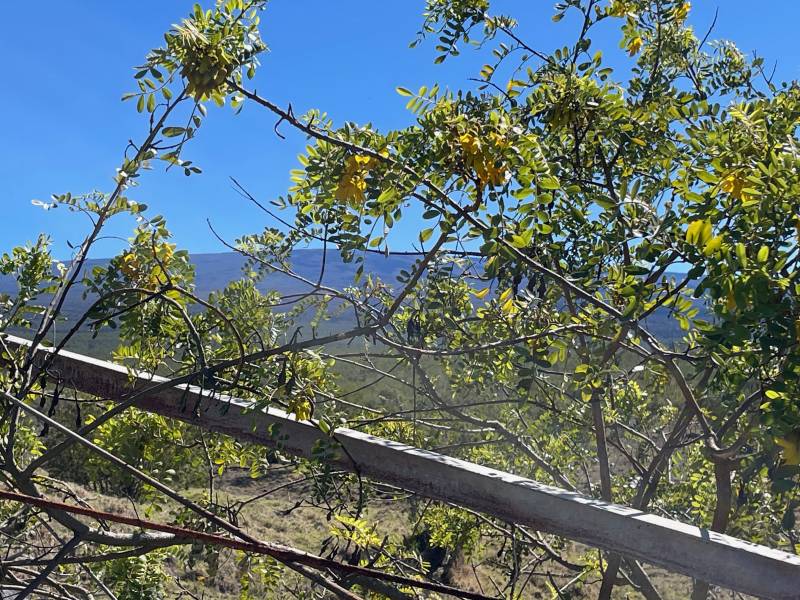Large Legacy Land Property – Make Your Home Within a Sandalwood Forest
Hawaiʻi Life calls our specialized practice area Conservation and Legacy Landsbecause often the properties we include have conservation values, but are not going to be strictly preserved in an entirely undeveloped state or acquired by a public or non-profit entity. Often these legacy lands have agricultural classification by the state and corresponding zoning by the County. Where conservation comes in is that there is value in not chopping them up into 20-acre gentleman farm parcels. We view these as legacy lands with historic, cultural and agricultural significance, whether or not formally protected by deed restrictions such as conservation easements.
The legacy land listings featured in this post are two large tracts consisting of dryland forest in South Kona. The current owner is employing dozens of workers to harvest dead and dying sandalwood trees and distill high-valued essential oil, the sales of which fund continued restoration of forest with species that are endemic to Hawaii. They will continue to own and steward an adjacent parcel, and they are under contract for the same services on adjacent lands owned by Kamehameha Schools.

Two large parcels offered for sale, with the owner keeping the middle parcel, Hāloa ʻāina, where sandalwood oil is distilled for sale to a major essential oil retail company.
History of Hāloa ʻĀinaʻs Forest Restoration and Conservation Efforts
The first time I heard about Hāloa ʻĀina, the native sandalwood and koa forest restoration project on hundreds of acres in south Kona, was at the Hawaii State Legacy Land Conservation Commission meetings I attended in 2018 and wrote about on this blog. The family who owns and stewards these parcels presented their historical ties to the land, and their kuleana to restore the native ecosystem which had been degraded by years of cattle ranching. They were also concerned that neighboring parcels and been subdivided and the chance to preserve a large part of the ecosystem would be lost.
Recently I had the opportunity to tour the current Hawaiʻi Life legacy land listing, consisting of two of the three parcels owned by the family. The two parcels can be purchased separately, but together total 1,581.40 acres in native dryland forest, with active restoration ongoing. In touring through the properties, I could see what a remarkable difference there was between areas that had been reforested, and those that were still recovering from years of grazing and invasive species. I learned something I never knew about the fragrant sandalwood: sandalwood is a hemi-parasitic root requiring a host to achieve maturation, so supportive nitrogen-fixing native trees such as koa and mamane are also planted as restoration host species.

Along the boundary of the north parcel, remains of historic ranch infrastructure, volcano views of Hualalai and Mauna Loa, and native plants such as mamane, provide an unmatched sense of place.
In other words, sandalwood cannot be monocropped; it must be interplanted with amenable species that co-evolved and are, therefore, also important endemic Hawaiian trees.
A new owner could take advantage of all the work already done to define and secure agreements for conservation easements to be funded through the Forest Legacy Program.
BUT a new owner would not have to place 100% of the lands in conservation easements. You could choose from several potential home sites easily accessible by existing drivable roads through the parcels. Millions of dollars already have been invested in fencing and ungulate removal to protect new tree plantings, that would also protect any other crops you wished to grow or even just a household vegetable and flower garden.
To summarize, the opportunity here is just what I hear sustainability-minded buyers say they want:
- A legacy homestead with privacy but within easy driving distance of amenities and an international airport.
- An income producing but light-on-the-land forestry program through harvesting sandalwood trees at the end of their lifespan for essential oil production and selling wood from fallen koa trees to woodworkers. This activity provides income to offset the costs of the reforestation effort, while supporting the local economy with employment opportunities.
- Conservation of an important forest ecosystem, for carbon sequestration, bird habitat, and restoration of tree species that carry cultural as well as ecosystem importance.
Of course this only scratches the surface of what I learned on a half-day visit. I would be happy to explain more about conservation easements in general, or about these properties in particular, if this opportunity might be the right one for you.

Leave your opinion here. Please be nice. Your Email address will be kept private, this form is secure and we never spam you.